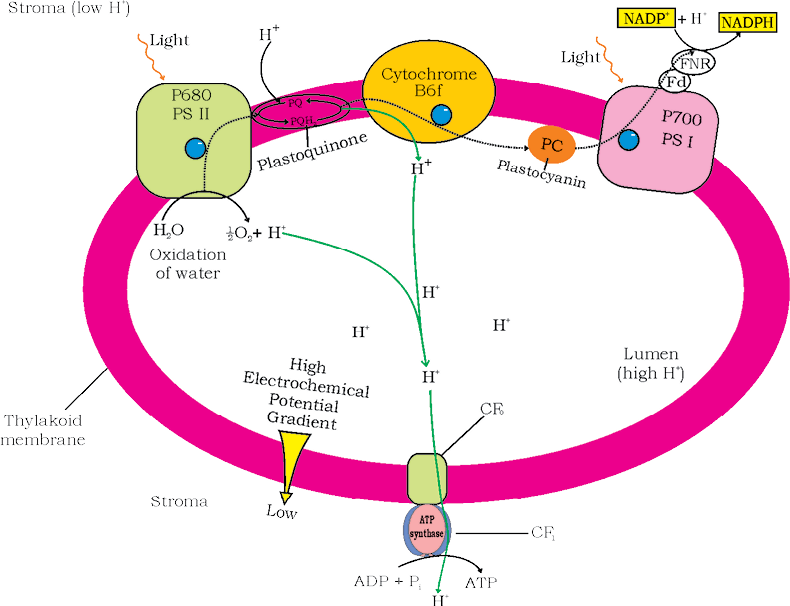Let us now try and understand how actually ATP is synthesised in the chloroplast. The chemiosmotic hypothesis has been put forward to explain the mechanism. Like in respiration, in photosynthesis too, ATP synthesis is linked to development of a proton gradient across a membrane. This time these are the membranes of thylakoid. There is one difference though, here the proton accumulation is towards the inside of the membrane, i.e., in the lumen. In respiration, protons accumulate in the intermembrane space of the mitochondria when electrons move through the ETS (Chapter 14).
Let us understand what causes the proton gradient across the membrane. We need to consider again the processes that take place during the activation of electrons and their transport to determine the steps that cause a proton gradient to develop (Figure 13.7).

Figure 13.7 ATP synthesis through chemiosmosis
(a) Since splitting of the water molecule takes place on the inner side of the membrane, the protons or hydrogen ions that are produced by the splitting of water accumulate within the lumen of the thylakoids.
(b) As electrons move through the photosystems, protons are transported across the membrane. This happens because the primary accepter of electron which is located towards the outer side of the membrane transfers its electron not to an electron carrier but to an H carrier. Hence, this molecule removes a proton from the stroma while transporting an electron. When this molecule passes on its electron to the electron carrier on the inner side of the membrane, the proton is released into the inner side or the lumen side of the membrane.
(c) The NADP reductase enzyme is located on the stroma side of the membrane. Along with electrons that come from the acceptor of electrons of PS I, protons are necessary for the reduction of NADP+ to NADPH+ H+. These protons are also removed from the stroma. Hence, within the chloroplast, protons in the stroma decrease in number, while in the lumen there is accumulation of protons. This creates a proton gradient across the thylakoid membrane as well as a measurable decrease in pH in the lumen.
Why are we so interested in the proton gradient? This gradient is important because it is the breakdown of this gradient that leads to the synthesis of ATP. The gradient is broken down due to the movement of protons across the membrane to the stroma through the transmembrane channel of the CF0 of the ATP synthase. The ATP synthase enzyme consists of two parts: one called the CF0 is embedded in the thylakoid membrane and forms a transmembrane channel that carries out facilitated diffusion of protons across the membrane. The other portion is called CF1 and protrudes on the outer surface of the thylakoid membrane on the side that faces the stroma. The break down of the gradient provides enough energy to cause a conformational change in the CF1 particle of the ATP synthase, which makes the enzyme synthesise several molecules of energy-packed ATP.
Chemiosmosis requires a membrane, a proton pump, a proton gradient and ATP synthase. Energy is used to pump protons across a membrane, to create a gradient or a high concentration of protons within the thylakoid lumen. ATP synthase has a channel that allows diffusion of protons back across the membrane; this releases enough energy to activate ATP synthase enzyme that catalyses the formation of ATP.
Along with the NADPH produced by the movement of electrons, the ATP will be used immediately in the biosynthetic reaction taking place in the stroma, responsible for fixing CO2, and synthesis of sugars.